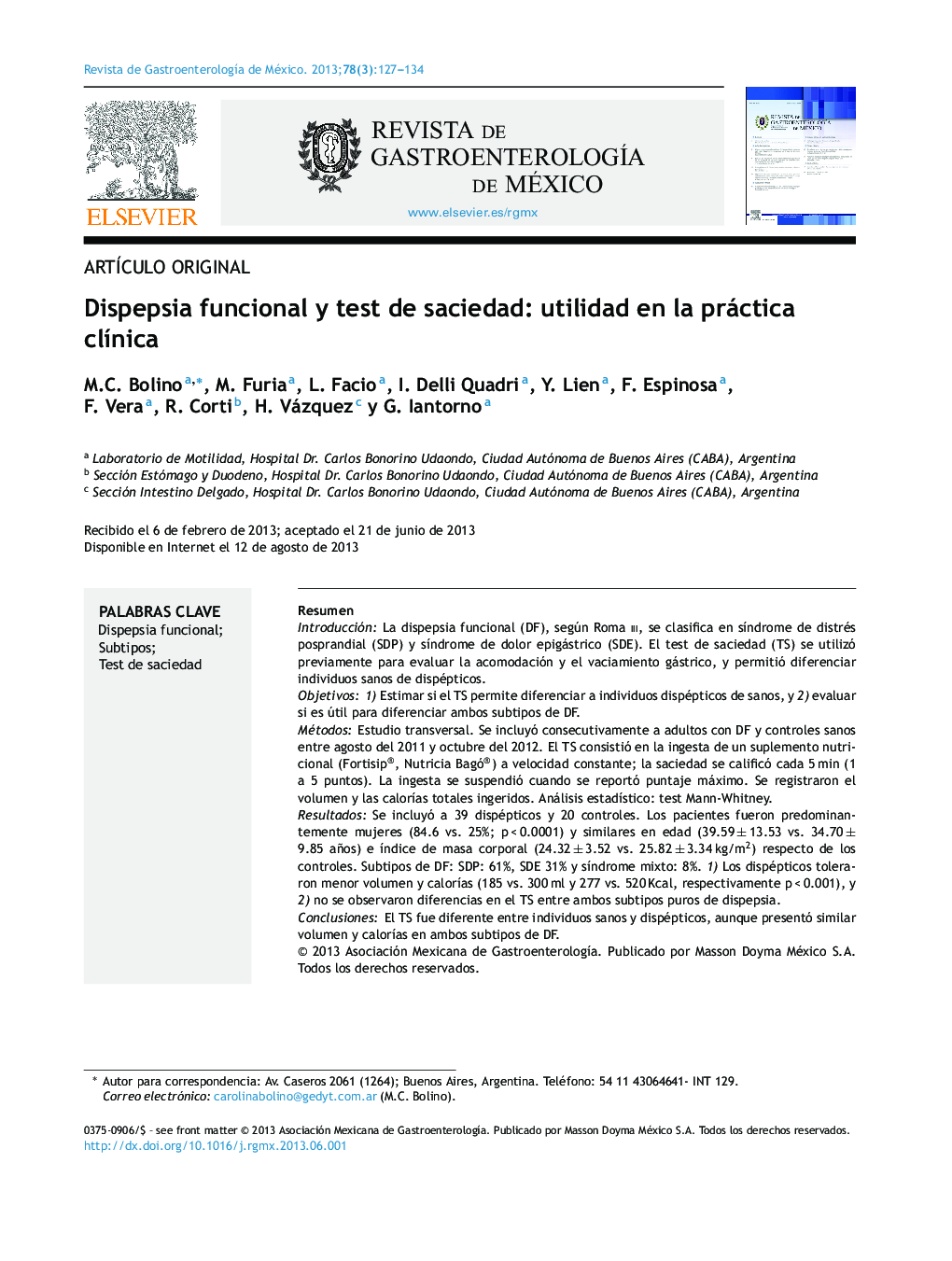| کد مقاله | کد نشریه | سال انتشار | مقاله انگلیسی | نسخه تمام متن |
|---|---|---|---|---|
| 3318824 | 1211647 | 2013 | 8 صفحه PDF | دانلود رایگان |

ResumenIntroducciónLa dispepsia funcional (DF), según Roma III, se clasifica en síndrome de distrés posprandial (SDP) y síndrome de dolor epigástrico (SDE). El test de saciedad (TS) se utilizó previamente para evaluar la acomodación y el vaciamiento gástrico, y permitió diferenciar individuos sanos de dispépticos.Objetivos1) Estimar si el TS permite diferenciar a individuos dispépticos de sanos, y 2) evaluar si es útil para diferenciar ambos subtipos de DF.MétodosEstudio transversal. Se incluyó consecutivamente a adultos con DF y controles sanos entre agosto del 2011 y octubre del 2012. El TS consistió en la ingesta de un suplemento nutricional (Fortisip®, Nutricia Bagó®) a velocidad constante; la saciedad se calificó cada 5 min (1 a 5 puntos). La ingesta se suspendió cuando se reportó puntaje máximo. Se registraron el volumen y las calorías totales ingeridos. Análisis estadístico: test Mann-Whitney.ResultadosSe incluyó a 39 dispépticos y 20 controles. Los pacientes fueron predominantemente mujeres (84.6 vs. 25%; p < 0.0001) y similares en edad (39.59 ± 13.53 vs. 34.70 ± 9.85 años) e índice de masa corporal (24.32 ± 3.52 vs. 25.82 ± 3.34 kg/m2) respecto de los controles. Subtipos de DF: SDP: 61%, SDE 31% y síndrome mixto: 8%. 1) Los dispépticos toleraron menor volumen y calorías (185 vs. 300 ml y 277 vs. 520 Kcal, respectivamente p < 0.001), y 2) no se observaron diferencias en el TS entre ambos subtipos puros de dispepsia.ConclusionesEl TS fue diferente entre individuos sanos y dispépticos, aunque presentó similar volumen y calorías en ambos subtipos de DF.
IntroductionAccording to the Rome III Criteria, functional dyspepsia (FD) is classified as postprandial distress syndrome (PDS) and epigastric pain syndrome (EPS). On the other hand, the satiety test (ST) has been used to evaluate gastric accommodation and emptying, distinguishing healthy individuals from those with dyspepsia.AimsTo determine whether the ST can distinguish dyspeptic individuals from healthy ones and to evaluate its usefulness in differentiating the two FD subtypes.MethodsAdults with FD were consecutively enrolled in a cross-sectional study within the time frame of August 2011 and October 2012. Healthy subjects participated as controls. The ST consisted of the intake of a nutritional supplement (Fortisip®, Nutricia Bagó®) at a constant speed; satiety was graded at 5-minute intervals (1 to 5 points). Intake was suspended when the maximum score was reported. The total ingested volume and caloric intake was recorded and the Mann-Whitney U test was used in the statistical analysis.ResultsThe study included 39 dyspeptic patients and 20 control individuals. The patients were predominantly women (84.6 vs. 25%; p < 0.0001) and they were similar in age (39.59 ± 13.53 vs. 34.70 ± 9.85 years) and BMI (24.32 ± 3.52 vs. 25.82 ± 3.34 kg/m2) with respect to the controls. The FD subtype percentages were PDS: 61%, EPS: 31%, and Mixed syndrome: 8%. There was a lower ingested volume and caloric intake on the part of the dyspeptic patients (185 vs. 300 ml and 277 vs. 520 Kcal, respectively. Both: P<.001). No differences in the ST were observed between the two pure dyspepsia subtypes.ConclusionsThere was a difference in the ST between healthy individuals and those with dyspepsia, but the ingested volume and caloric intake in the two FD subtypes were similar.
Journal: Revista de Gastroenterología de México - Volume 78, Issue 3, July–September 2013, Pages 127–134